
JOURNAL OF GLASS STUDIES
Scope & Guideline
Advancing Knowledge in Glass as Art and Material.
Introduction
Aims and Scopes
- Historical and Archaeological Studies:
The journal emphasizes the historical context of glass objects, exploring archaeological findings from various cultures and epochs, including Roman, Medieval, and Renaissance periods. - Material Science and Technological Advances:
Research often includes a focus on the material properties of glass, including its chemical composition, production methods, and innovations in glassmaking techniques. - Cultural and Artistic Perspectives:
The journal showcases studies that analyze the cultural significance of glass artifacts, their artistic value, and their role in social and economic contexts. - Provenance and Authenticity:
There is a consistent focus on provenance studies, investigating the origins and authenticity of glass objects, which is crucial for collections and exhibitions. - Interdisciplinary Approaches:
The journal encourages interdisciplinary research, integrating methods from art history, archaeology, materials science, and anthropology to provide a comprehensive understanding of glass.
Trending and Emerging
- Archaeometric Analysis:
Recent papers increasingly employ archaeometric techniques to analyze glass artifacts, providing insights into their composition, production methods, and historical context, which enhances the understanding of ancient technologies. - Cultural Significance of Glass in Society:
There is a growing interest in exploring the sociocultural implications of glass artifacts, including their roles in rituals, identity, and trade, reflecting a broader trend in material culture studies. - Sustainability and Glass Recycling:
Emerging discussions around sustainability and the recycling of glass are becoming more prominent, as researchers investigate historical practices and modern applications in light of environmental concerns. - Interdisciplinary Research Collaborations:
An increase in interdisciplinary collaborations is evident, with studies integrating perspectives from art history, archaeology, and material science, indicating a move towards more holistic approaches to glass research. - Global Perspectives on Glassmaking:
There is an expanding focus on non-Western glass traditions, showcasing a more global approach that recognizes the significance of glassmaking in diverse cultural contexts.
Declining or Waning
- Traditional Glassmaking Techniques:
Research on traditional glassmaking methods has decreased, possibly due to a growing focus on modern techniques and materials science, which offer more innovative insights into glass production. - Regional Glass Traditions:
There has been a noticeable decline in studies dedicated exclusively to specific regional glass traditions, suggesting a shift towards broader, more global approaches to glass research. - Historical Figures in Glassmaking:
While obituaries and biographical studies of historical figures in glassmaking were more prevalent in earlier issues, recent publications show a trend towards more abstract research themes rather than individual narratives. - Decorative Techniques in Isolation:
Articles focusing solely on decorative techniques, such as engraving or enameling, have become less common, indicating a potential shift towards more comprehensive studies that integrate these techniques into broader historical narratives.
Similar Journals
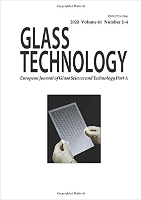
Glass Technology-European Journal of Glass Science and Technology Part A
Exploring New Horizons in Glass Materials and ChemistryGlass Technology - European Journal of Glass Science and Technology Part A, published by the SOC GLASS TECHNOLOGY in the United Kingdom, is an esteemed journal dedicated to advancing the field of glass science and technology. With a focus on ceramics, composites, and materials chemistry, the journal plays a pivotal role in disseminating significant research findings and innovations in glass technology. Despite its current positioning in the lower quartiles (Q4) of the 2023 category rankings, this journal serves as a valuable platform for emerging research and novel technologies within its domain. Researchers, professionals, and students are encouraged to explore the journal's contributions from 2006 through to 2024, which include peer-reviewed articles, reviews, and case studies essential for anyone involved in the glass industry or related fields. Though it operates under a subscription model, it maintains rigorous academic standards, ensuring that each publication meets the highest criteria for quality and relevance.
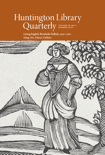
HUNTINGTON LIBRARY QUARTERLY
Advancing Scholarship in the Humanities Since 1964The Huntington Library Quarterly, published by University of Pennsylvania Press, is a distinguished academic journal that has been enriching the fields of History, Literature, and Visual Arts since its inception in 1964. With an ISSN of 0018-7895 and E-ISSN 1544-399X, this journal operates from the cultural and scholarly hub of the United States, specifically from Philadelphia, PA. Although unlisted as an Open Access journal, it maintains a robust academic presence with its Q3 ranking in key categories such as History, Literature and Literary Theory, and Visual Arts and Performing Arts for the year 2023. The journal curates a range of scholarly articles that explore the rich interdisciplinary connections among these fields, making it an invaluable resource for researchers, professionals, and students alike who seek to deepen their understanding of cultural and historical contexts. With a strong Scopus ranking, situated within the 52nd to 69th percentiles across its related categories, The Huntington Library Quarterly continuously aims to challenge conventions and inspire innovative discourse in the humanities.
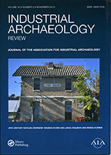
Industrial Archaeology Review
Revealing the Stories Behind Industrial LandscapesIndustrial Archaeology Review, published by Routledge Journals, Taylor & Francis Ltd, is a leading scholarly journal dedicated to the field of industrial archaeology. With its ISSN 0309-0728 and E-ISSN 1745-8196, this journal provides a critical platform for researchers, professionals, and students interested in the exploration of industrial heritage and the social, economic, and environmental implications of past industrial practices. The journal's impact is underscored by its positioning in the Q3 category in both the archaeology arts and humanities and archaeology social sciences quartiles for 2023, reflecting its significance within the academic community. Covering a broad temporal span from 1976 to 2024, Industrial Archaeology Review promotes interdisciplinary dialogue and encourages innovative approaches to the study of industrial heritage. Although not an open-access journal, it continues to contribute valuable insights into the preservation and interpretation of industrial sites, making it an essential resource for any scholar immersed in this fascinating field.

Journal of Mosaic Research
Fostering scholarly dialogue across diverse artistic disciplines.Journal of Mosaic Research, published by ULUDAG UNIVERSITY, MOSAIC RESEARCH CENTER, is a distinguished open-access journal dedicated to the fields of archaeology, visual arts, and performing arts. Since its establishment in 2019, the journal has been committed to advancing scholarly discourse through innovative research and critical analysis, and it transitioned to an open-access model in 2021 to enhance accessibility and dissemination of knowledge. With an ISSN of 1309-047X, this journal has been recognized for its quality, evidenced by its 2023 rankings which place it in the Q3 quartile for both archaeology and visual arts and performing arts within the Scopus database. Operating from Bursa, Turkey, the journal provides a platform for researchers, professionals, and students to publish their findings, share insights, and engage with contemporary topics in these vital fields of study. As it continues to grow, the Journal of Mosaic Research aims to foster interdisciplinary collaborations and inspire future generations of scholars.
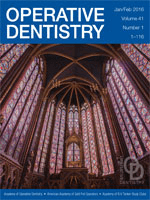
OPERATIVE DENTISTRY
Fostering Excellence in Dental Care through Scholarly ContributionsOPERATIVE DENTISTRY is a premier academic journal dedicated to the advancement of knowledge in the field of dentistry, particularly focusing on operative techniques, materials, and innovations. Published by OPERATIVE DENTISTRY INC, this journal holds an esteemed reputation as indicated by its classification within the Q1 quartile in Dentistry and Q2 in Medicine for 2023, and it ranks #40 out of 132 in the general dentistry category, placing it in the 70th percentile according to Scopus. With a commitment to high-quality research since its inception in 1976, the journal serves as an essential resource for researchers, practitioners, and students alike, fostering the dissemination of cutting-edge findings and developments in operative dentistry. The journal does not have an open access option; however, it provides access to a wealth of information crucial for the enhancement of clinical practice and patient care. With its headquarters located at Indiana University School of Dentistry in Indianapolis, IN, OPERATIVE DENTISTRY remains at the forefront of dental research and education.

Anales de Historia del Arte
Advancing Scholarship in Visual and Performing ArtsAnales de Historia del Arte is a distinguished open-access journal published by Univ Complutense De Madrid, focusing on the diverse fields of art history, visual arts, and performing arts. Since its inception in 2005, this journal has provided a platform for scholars and researchers to disseminate original research, critical reviews, and theoretical discussions that enhance the understanding of artistic developments throughout history. Located in Madrid, Spain, and embracing a global perspective, it plays a crucial role in fostering dialogue within the arts and humanities sectors. The journal is currently categorized in the Q4 quartiles of its respective fields according to Scopus metrics, ranking among approximately 15-25% of publications within the arts and humanities domains as of 2023. Researchers and academics can take advantage of the open-access model, allowing for wider dissemination of knowledge and enhancing the accessibility of critical discourse in art history. Explore Anales de Historia del Arte for its significant contributions to emerging trends and established research in the arts.

BOLETIN DE LA SOCIEDAD ESPANOLA DE CERAMICA Y VIDRIO
Shaping the Future of Industrial Engineering through Open AccessBOLETIN DE LA SOCIEDAD ESPANOLA DE CERAMICA Y VIDRIO, published by Elsevier, is a premier open-access journal dedicated to advancing research in the fields of Ceramics and Composites, Industrial and Manufacturing Engineering, and Mechanics of Materials. With an impressive impact factor and a strong ranking within its categories—Q2 in 2023 for multiple engineering domains—it serves as a vital resource for academics, industry professionals, and students alike. The journal has embraced an open-access model since 2015, providing widespread accessibility to the latest findings and innovations in ceramic and glass sciences, thus encouraging collaboration and knowledge sharing within the global research community. Published quarterly, and with a focus on interdisciplinary applications, the BOLETIN DE LA SOCIEDAD ESPANOLA DE CERAMICA Y VIDRIO is not only influential in shaping research agendas but also essential for anyone engaged in the evolving landscape of materials science.
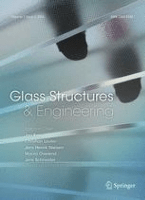
Glass Structures & Engineering
Exploring the Boundaries of Glass Engineering.Glass Structures & Engineering, published by SPRINGER INT PUBL AG, stands as a significant platform in the field of architectural and structural engineering, with a strong focus on advancements and innovative applications of glass in construction. With its ISSN 2363-5142 and E-ISSN 2363-5150, this prestigious journal holds a commendable position, evidenced by its Q1 classification in Architecture and Q2 ranking in both Building and Construction and Civil and Structural Engineering as of 2023. Since its inception in 2016, Glass Structures & Engineering has aimed to disseminate cutting-edge research findings, theoretical approaches, and case studies that explore the multifaceted uses of glass in modern infrastructure. Researchers, professionals, and students alike will find this journal an invaluable resource for the latest trends and methodologies in the evolving landscape of architectural design and structural integrity. Although it does not offer Open Access options, the journal remains an indispensable source for quality scholarly content in Switzerland and beyond.
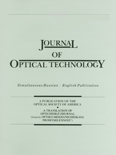
JOURNAL OF OPTICAL TECHNOLOGY
Pioneering Insights in Optical ScienceJOURNAL OF OPTICAL TECHNOLOGY, published by the Optica Publishing Group, serves as a vital resource for researchers and professionals in the fields of optical technology and related disciplines. Established with a commitment to advancing knowledge, this journal spans a broad spectrum of topics, including applied mathematics, atomic and molecular physics, and various engineering disciplines, with a converged publication period from 1995 to 2024. Although it currently holds a Q4 ranking across multiple categories in 2023, it is an important platform for innovative research ideas in a rapidly evolving field. The absence of Open Access may guide readers to explore alternative access options through institutional subscriptions. The journal’s ISSN is 1070-9762 and its E-ISSN is 1091-0786, ensuring accessibility for a global audience. As a publication aimed at fostering scholarly communication, it invites contributions that highlight emerging trends and novel developments in optical technology, catering to a multifaceted audience of researchers, professionals, and students.

METROPOLITAN MUSEUM JOURNAL
Exploring Best Practices in MuseologyMETROPOLITAN MUSEUM JOURNAL, published by the University of Chicago Press, serves as a vital platform for researchers, professionals, and students in the fields of Conservation and Museology. With an ISSN of 0077-8958 and an E-ISSN of 2169-3072, this journal emphasizes the importance of scholarly discourse on art preservation and museum practices. Although it currently holds a Q4 ranking in both Conservation and Museology according to the 2023 category quartiles, the journal continues to contribute to advancements and discussions within these vital fields. Located in Belgium, the journal's mission is to illuminate best practices, innovative techniques, and significant case studies that inform the future of museum work. As an indispensable resource for those dedicated to the arts and humanities, METROPOLITAN MUSEUM JOURNAL fosters a community for exchanging ideas and insights, crucial for the ongoing development and understanding of museum methodologies.